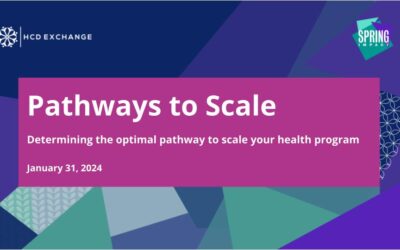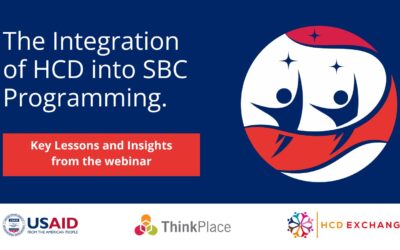Over the last few years, HCD approaches have been used to design and pilot interventions to global health challenges such as HIV. On December 8, 2021, the HCDExchange Community of Practice came together for a webinar that focused on three of such interventions with the aim of sharing the similarities and differences across projects, challenges and push-back against the HCD approach, partnership and stakeholder management and how to scale the projects further.
The interventions in focus were the “V” project in Zimbabwe, PSE in Lesotho and the Malkia Klabu Adolescent Girl Program in Tanzania.
V Project and PSE
“V” is an innovative approach designed to increase uptake and adherence of pre-exposure prophylaxis (PrEP) in adolescent girls and young women who are at high risk of getting infected by HIV. It is a brand and service delivery strategy that positions PrEP as aspirational and empowering so that the attention is shifted from not “getting HIV” to “empowering yourself.” Through bold visuals, empowering messages and the assistance of “PrEP buddies,” adolescent girls and young women are empowered to take care of themselves. It was first piloted in South Africa and then in Zimbabwe as “V” and in Lesotho as PSE.
Malkia Klabu Adolescent Girl Program
The goal of the Malkia Klabu Adolescent Girl Program is to develop an intervention to motivate young women to seek HIV self-test kits and contraception at drug shops and ultimately reduce HIV incidents, unintended pregnancy and maternal mortality in Tanzania.
One important thing to note is that in addition to using an HCD approach, the project also used theoretical learnings from behavioral economics to ensure insights could identify underlying behavioral biases to explain why young women and shopkeepers acted the way they did, and incorporate behavioral aspirations into the solution.
Speakers
- Moderator: Rahima Dosani, MBA, MPH Senior Advisor, Market Access, USAID
- Jenny Liu, PhD, MPP, Associate Professor of Health Economics, Department of Social and Behavioral Science
- Catherine Wandie, MBA, MPH, HCD Project Manager, Matchboxology
- Tinovonga Mawoyo, Communications Specialist, Population Solutions for Health
- Gwendoline Chapwanya, Project Coordinator, Pangea Zimbabwe AIDS Trust
Here are some key highlights from the conversation:
Meaningful youth engagement in action
One of the major similarities across all three projects was how they were designed not on behalf of adolescent girls and young women (AGYW) but directly with them. From PrEP buddies to “AMBASSADDORs” and a Youth Advisory Council, young people played a critical role in the insights gathering, solution design and implementation of the project. For example, in Zimbabwe and Lesotho, the V teams worked with young girls to create demand for PrEP and had adolescent ambassadors who went into the community to talk about PrEP, drive demand for it and recruit users. This worked well because they intimately know the challenges that girls face in relationships. In Lesotho, they assisted the team with interpretation, on the ground travel and research. They were a key part of the whole program.
HCD partnerships and stakeholder management
It was important to identify key stakeholders across projects because with those relationships came buy-in and successful project implementation. In Zimbabwe, the V team worked with the HIV Prevention Unit at the Ministry of Health. They shared what V was and what the project was set out to achieve. The V team also participated in a Prevention Technical Working Group that primarily focuses on PreP at the beginning of the project so as to get a feel of what other implementing partners were doing.
In Lesotho, the V team received support from USAID’s networks and JHPIEGO during insights gathering and implementation. Another important group of stakeholders that were instrumental during the implementation phase were the parents and partners of the AGYW because they helped support and empower the girls.
Pushback against the HCD approach
Dr Jenny Liu shared that HCD is now creeping into public health research and it feels like new territory. She says, “the observation that I have is that researchers typically look at human-centered design with a bit of skepticism because the design process is mysterious and there is little written about what is conducted to yield amazing, creative and holistic solutions that everybody gets excited about. There is a need to harness the power of human-centred design in this approach while demystifying the process to foster broader adoption and push the envelope of public health programming and intervention design into a new space.”
The Malkia Klabu project team has therefore tried to improve documentation of what they did through each step of the process. The hope is that this will help improve transparency and the replicability of the HCD process so as to engage researchers more and gain greater accessibility.
What it will take to scale up projects
V project in Zimbabwe
The team is looking at three elements that will help with scaling up:
Continuing to get buy-in from various stakeholders
There is the need for buy-in from the Ministry of Health at the district level because there is already buy-in at the national level. There is also the need to get buy-in from service providers because they will be the people that AGYW will be seeing when they want to access PrEP. They will need to understand what “V” is and get used to saying V instead of saying PreP. Lastly, there is the need for buy-in from ambassadors who will be peer champions on the ground.
Training
The success of the pilot phase was possible because the PrEP ambassadors were well trained and understood what V is, the discussion guides and how to bring AGYW on board. At scale, they will need to train and build capacity with the service providers..
Resources
The districts that are being scaled into will need to have materials such as posters and banners. There will also be follow up with the districts, ambassadors and service providers.
PSE project in Lesotho
There are programs providing menstrual products, family planning, self-care kits for AGYW in Lesotho and so the team looked at bundling all the different services that are targeting this group to make it convenient for the AGYW. Bundling the product also helps reduce stigma because there are products such as contraception, sanitary products and not just HIV prevention products.
Malkia Klabu in Tanzania
One of the criticisms of HCD is how tailored solutions are for a specific context or population so it is difficult to know if it will work in another context. With this in mind, the Malkia Klabu team was intentional about combining HCD with theoretical constructs from behavioral economics and methods from implementation science.
The analysis and solutions from the formative research are founded on some theoretical basis for how individuals can predictively behave in their environments and engage with the solution. Additionally, there is the added rigor and evidence of implementation science methods to capture qualitative and quantitative learnings from the pilot. These three layers will ensure the adaptability of the final solution in different contexts.
The importance of success stories in scaling up
Sharing the success stories from the implementation of the project helps to create enthusiasm because people see that process worked well.
Helpful resources
- Watch the full webinar here
- Check out the presentation on the V project in Zimbabwe and the PSE project in Lesotho here
- Check out the presentation about the Malkia Klabu project in Tanzania here
- Read about the V project in Zimbabwe here
- Read about the PSE project in Lesotho here
- Find all resources on the V project here
- Learn about the Malkia Klabu project here



